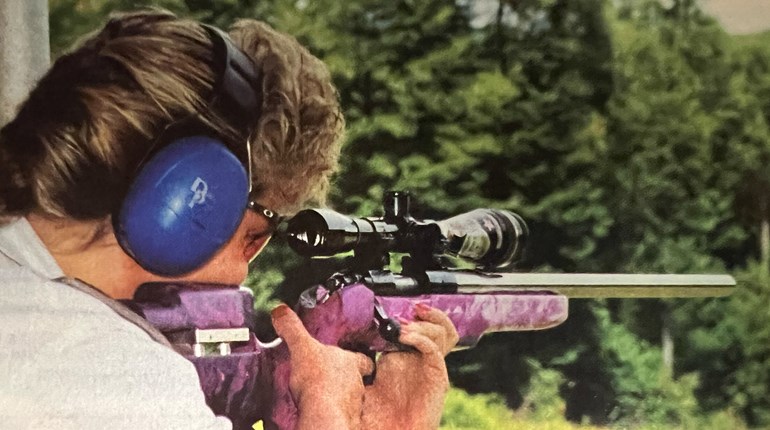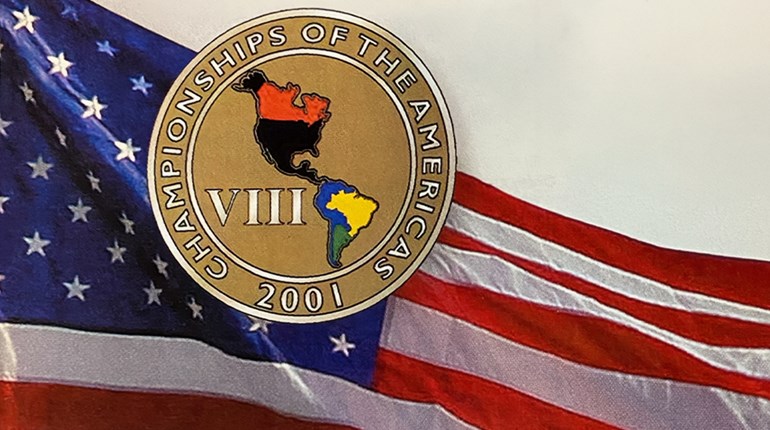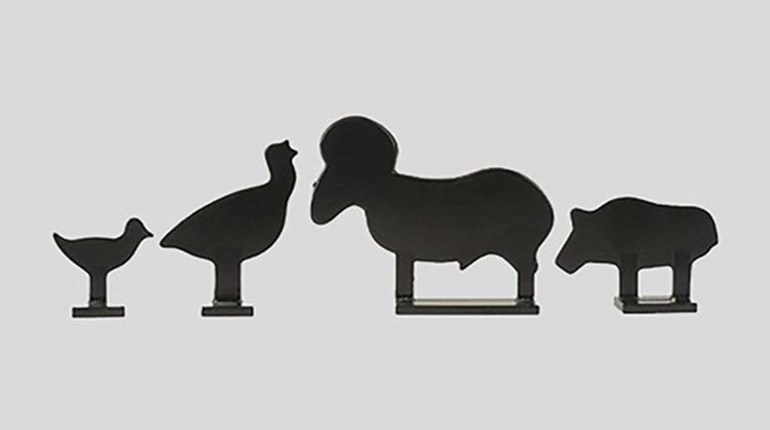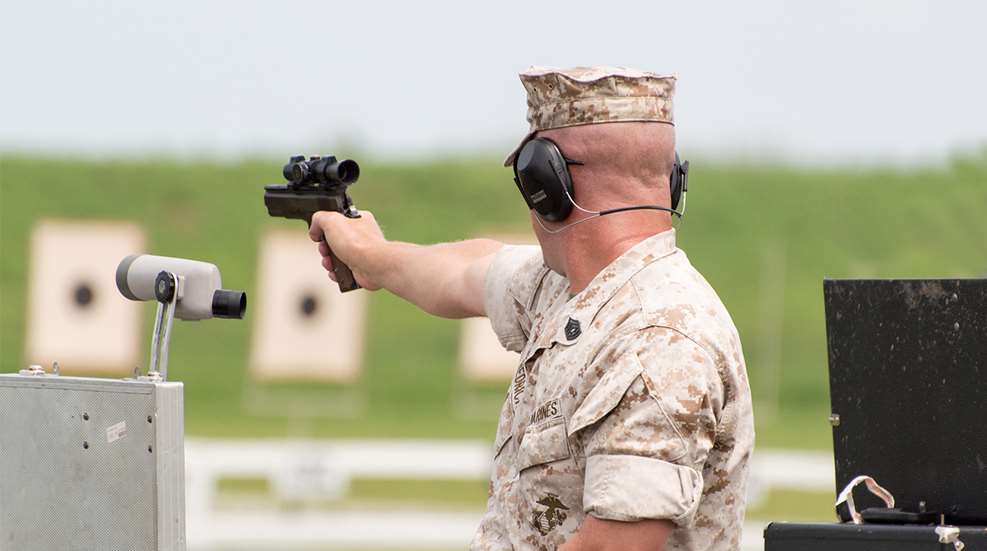
WARNING: All technical data in this publication, especially for handloading, reflect the limited experience of individuals using specific tools, products, equipment and components under specific conditions and circumstances not necessarily reported in the article and over which the National Rifle Association (NRA) has no control. The data has not otherwise been tested or verified by the NRA. The NRA, its agents, officers and employees accept no responsibility for the results obtained by persons using such data and disclaim all liability for any consequential injuries or damages.
Reprinted from the June, 1998 issue of Shooting Sports USA, this article is still quoted by retired Marine and 12-time NRA National Pistol Champion Brian Zins.
The wind blows. It rains cats, dogs and small livestock. The .45 ACP 1911 automatic pistol in your hand bucks like a half-crazed bronco on steroids. The aiming black of the 50-yard slow fire target dances through the shimmering mirage in your dot scope like Little Egypt. You’re going to pull the trigger 270 times in this competition, and every shot is going to count for score.
That’s NRA Conventional Pistol competition, sometimes called three-gun pistol, bullseye pistol, or precision pistol, and for over a century it’s been the most popular of the bullseye pistol events fired in this country. Civilian, military and police shooters alike are endlessly intrigued, challenged and frustrated by this shooting game. It puts every shooter and his or her equipment to a difficult test each time the range officer’s whistle sounds and the targets turn.
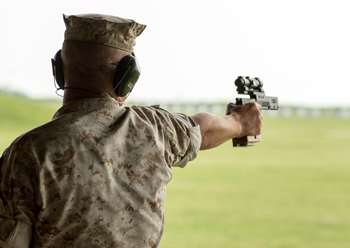
Each NRA Conventional Pistol competitor is interested in squeezing every possible extra point and “X” out of their equipment and personal performance in the three-gun pistol events. Equipment is modified to suit the individual shooter and ammunition is carefully matched to each gun—all in hopes of shaving a few fractions of an inch off the average group size, giving the shooter a bit more margin for error and hopefully a better score in the process. Because the Centerfire and .45 Caliber stages of the NRA Conventional Pistol competition format make up two thirds of the potential match score, and because many if not most shooters shoot the same .45 ACP gun in both of these stages, the intrinsic accuracy of ammunition for the .45 ACP becomes of paramount importance. “Good” isn’t good enough in the .45 ACP accuracy department.
USMC Shooters
For much of the history of NRA Conventional Pistol competition, the service team that has set the pace for everyone else has worn the uniform of the United States Marine Corps. Over the past several years [Editor’s note: This article was originally written in 1998.], the U.S. Marine Corps Pistol Team, headquartered at Quantico, VA, has undertaken extensive research and testing to develop a match-quality handload for the .45 ACP that has proven to be second to none in accuracy and reliability. Rumors and speculation about the actual make-up of this load, along with its accuracy potential, have been making the rounds of firing lines across the country since USMC Pistol Team members won their recent back-to-back National Individual Conventional Pistol Championships.
This is the inside story of how that load was developed, and how you can build it at your own loading bench, just in time for your next big three-gun match or for Camp Perry.
Handload Consistency
Capt. Dan O’Connor, Officer in Charge of the team in 1996, had been receiving reports on the erratic accuracy of the factory match loads then supplied to the Marine shooters for their .45 ACP wadcutter match guns. One batch would shoot the center out of the X-ring at 50 yards all day long, while the next batch would open the group up to twice the size of that fired with the best ammo lots. During this time frame, USMC Pistol Team members also were engaged in their ongoing mission of conducting training clinics and firing schools for competitive shooters at matches across the country.
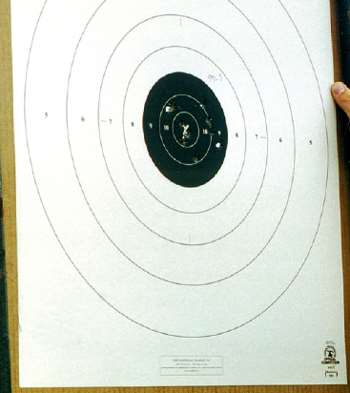
“The one constant thread in the comments of clinic and school participants nationwide was the belief that handloaded ammunition had the edge over factory match ammunition in the .45 ACP,” said O’Connor. “This widely-held belief was based on the idea that the careful hand assembly of quality components was the key to intrinsic accuracy in match ammunition. I instructed our staff to do a cost/benefit analysis of the possibility of building a match-grade .45 ACP handload in-house that would help give the USMC Team an edge in competition.”
Dorman Load
O’Connor tasked team member Gunnery Sgt. Randall C. Lawless to investigate how such a load could be developed. During this research, Lawless recalled a sample .45 ACP load that had been shared with him at a match in Sommersville, WV, several years earlier by Al Dorman, a 2670-level shooter and former National Civilian and .45 Caliber Conventional Pistol Champion. Dorman had developed the .45 ACP match load using input from a number of sources, including several benchrest rifle shooters and from former USMC match pistol armorer Michael Curtis.
The Dorman load was put together on a Dillon progressive press using: New Winchester primed brass, trimmed to a consistent length; the relatively new Nosler 185 grain JHP; 4.1 grains of Vihtavuori N310 to a loaded cartridge overall length of 1.20”. Dorman used only virgin Winchester primed cases for his long line (50 yards) loads, and once- or twice-fired WW cases with Winchester WLP (Winchester Large Pistol) primers on the short line (25 yards). Dorman noticed some clear differences in accuracy between the virgin and once-fired cases out of a machine rest as he was developing this load. Test accuracy initially was on the order of 1 5⁄8” out of Dorman’s guns at 50 yards from a machine rest. During informal tests at the West Virginia match, the Dorman load grouped well for the Marines, but didn’t function well in their guns because of their heavier recoil spring rates. Dorman recommended a 14-pound spring in the five-inch 1911 with this load.
“I called Nosler and asked them about this bullet.” said Dorman. “The Nosler people said the 185 JHP didn’t start out as a match bullet, but they just got very lucky on this one in the accuracy department.” The only downside to the Nosler 185 JHP load that Dorman was able to identify was the rounded nose of the hollow point cavity tends to cut a smaller hole in the target paper, usually about .32 to .38 cal.
“You have to be careful scoring this bullet and make sure both you and your scorer have a set of .45 cal. overlays, as a shot that looks well out may be touching or even breaking the next higher value scoring ring.” Dorman observed. “This load does make for some interesting discussions when scoring.”
Lawless thoroughly covered all the possible angles, investigating 37 different variations of the basic Dorman load with different charge weights, cases, primers and bullet seating depths. Extensive test lots of ammo were fired at 50 yards from several different Marine 1911 match guns mounted in Ransom machine rests. This exhaustive testing resulted in substantially similar accuracy results to those experienced by Dorman.
This handloaded match ammunition’s velocity is reported by several sources to range from 770 FPS up to 830 FPS in a tight match barrel, with most competition guns shooting at the upper end of this velocity range. Ten shot groups in the neighborhood of 1” center-to-center at 50 yards are the norm in the USMC match prepared 1911 pistols when fired out of a machine rest. Unlike Dorman’s original accuracy tests, the once-fired Winchester cases using the WLP primer are also reported to produce levels of accuracy in the USMC guns that are nearly identical to those put together with new Winchester brass. The Marines’ 1911 recoil spring rates range from 12 to 14 pounds depending on the individual gun and shooter. Recoil is reported by many to be softer than expected for a load producing these velocities. Marine match ammunition specialists handloaded approximately 58,000 rounds of .45 ACP match ammo for the USMC Pistol Team in 1997.
Caution Urged
Both Dorman and Lawless, along with the author, urge handloaders to use caution in the assembly of this ammunition (or any other handloaded ammunition, for that matter) as the relatively small powder charge weight and volume of N310 does not take up much space in the large .45 ACP case, and a double powder charge is possible if proper powder charging, handloading and quality control procedures are not carefully followed for each round during every loading session. Always visually verify that only a single charge of powder is in each case before seating the bullet.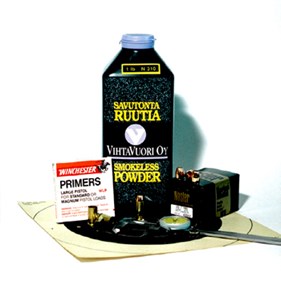
Concerns over the potential of such a double charge, and its disastrous effect on both gun and shooter, may be the reason no loads for the .45 ACP using N310 appear in the latest January 1998 edition of the Vihtavuori loading manual. N310 loads using a jacketed 185-grain bullet for the .45 ACP cartridge are reported by Dorman to have been published in earlier editions of the Vihtavuori manuals. The author has verified that this load information exists in an earlier, undated Vihtavuori manual, although it lists a velocity of 919 FPS.
Although the reloaders interviewed reported excellent success and full safety with this load, those readers who elect to try this load data should follow all standard load development procedures, such as starting with powder charges reduced 10 percent from those listed as maximum, and work up to the indicated load slowly while monitoring for signs of excess pressure or other problems. The author did not personally handload, test fire or chronograph samples of this .45 ACP load during the research and preparation of this article.
JHP Bullet
According to both Dorman and Lawless, the Nosler 185 JHP bullet has shown itself to be more accurate than either a cast lead semi-wadcutter or a jacketed semi-wadcutter in the .45 ACP. O’Connor, Dorman and Lawless all indicate that this accuracy stems from the nature of the manufacture of the JHP bullet. “A jacketed hollow point bullet is built from the base out so the concentricity is true, unlike the full metal jacketed bullet which is built from the nose out,” said Lawless.
“I just machine-rest tested 15 of our new 1911 match-prepared pistols,” continued Lawless. “All but one fired 10-shot groups with 9 Xs or better at 50 yards, and that’s with all nine or ten bullets being deep inside the X-ring. The one gun that didn’t shoot up to snuff went back to the armorer for a rework.”
Nosler affirmed that the 185 JHP is manufactured to their normal production standards. After the bullet tooling is set-up, test ammo samples built with several different loads are fired from a test barrel fitted to a fixed breech receiver to ensure that the tooling and set-up is correct. Only then is the set-up approved for a bullet production run. Nosler declined to give specifics regarding accuracy standards required for production run approval on the 185 JHP, but based on the demonstrated match accuracy of this bullet, it would be reasonable to assume they are very high indeed.
Problem Smithing
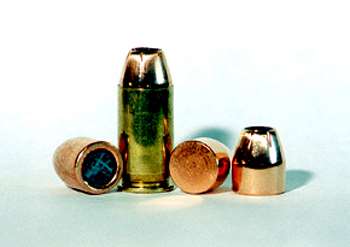
At this point, many readers may wonder about the feeding reliability of a jacketed hollow point bullet in a 1911 match pistol. Improved accuracy is all well and good, but if the points so gained are eaten up in alibi strings, it’s all for naught. According to Lawless, feeding is not a problem in a properly throated 1911 match barrel. The few reliability problems that did become apparent during development were traced to the Winchester case having a bit larger rim diameter than the Federal match cases then in use. The breech face on the Marines’ match 1911 slides was too small to allow the larger Winchester case rim to fully rise from the magazine, slip under the extractor hook and align with the barrel chamber properly as the slide went into battery. Opening the face of the slide to accommodate the larger case rim cured the problem.
“My own .45 match gun was the biggest reliability problem we had on the team,” said Lawless. “Once we opened up the slide’s breech face, it’s been 100 percent. I haven’t had a single misfeed all season.”
O’Connor mentioned that Black Hills Ammunition has shown some interest in producing a similar match load for competition shooters, and has been producing exceptionally accurate ammunition for both rifle and pistol shooters for some years. According to O’Connor, Black Hills is also producing an excellent match load in 9mm Parabellum which has shown tremendous accuracy potential in the Beretta Model 92/M9 series pistols now being brought online for interservice pistol matches. We can expect to see more of the Model 92/M9 series on firing lines in the future, as service armorers begin to turn more time and attention to building this series of pistols into match-capable firearms.
Barrel Work
Lawless and O’Connor also gave credit to the quality of barrels provided by Bar-Sto Precision Machine out of Twentynine Palms, California. Lawless indicated that these USMC barrels were chambered to a depth of approximately .904”, a bit beyond the SAAMI specs of .898”. In his research, Lawless found the new Winchester brass was well short of this measurement, and in the future new lots of USMC barrels may be chambered to a depth in the neighborhood of .896” to .894”. This helps create something of a short-throat barrel situation which can be very accurate with matching length cases, or can be lengthened if needed with a finish chamber reamer. Always check case length against chamber depth to avoid pinching a bullet in the case and creating a dangerous over-pressure situation.
Bar-Sto Precision confirmed the special nature of the barrels they have been supplying to the USMC Pistol Team armorers for some 15 years. Each starts out life as a billet of 416 stainless steel, and is machined to USMC match specs, with a longer length barrel hood, a special depth on the first locking lug recess, and plenty of extra metal for the USMC match armorer to remove it.
Editor’s Note: Keep in mind that this article was written in the late 1990s. While the load data is still relevant, minor facts such as Bar-Sto’s relocation to Sturgis, SD, additional cartridges now being offered by Black Hills Ammunition, the new Beretta M9A3 etc. should be noted.













